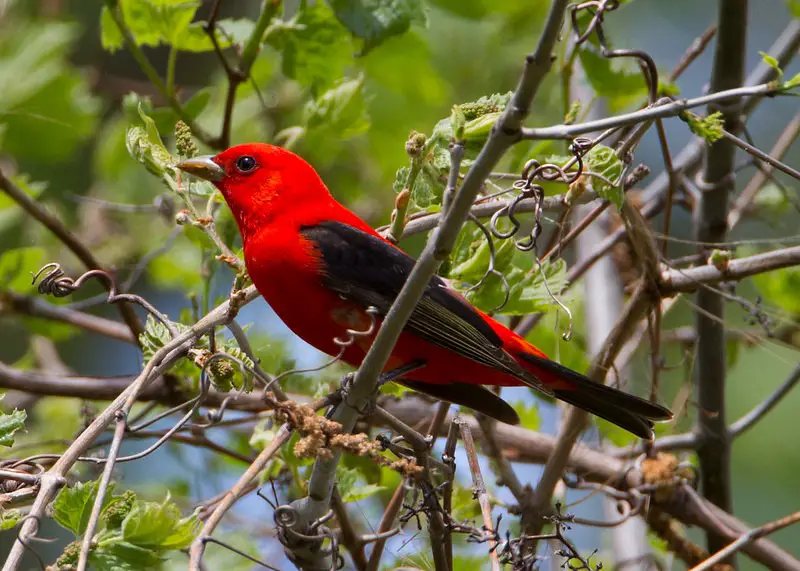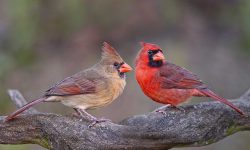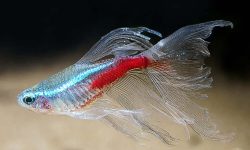The Scarlet Tanager (Piranga olivacea) is a migratory songbird widely admired for its brilliant red and black coloration and elusive lifestyle within North America’s mature deciduous forests. Their lives remain largely concealed in the forest canopy, a complex three-dimensional environment that influences every aspect of their behavior, particularly nesting. Understanding their nesting ecology offers insights into how species adapt to specific niches, balancing reproductive needs with environmental pressures.

The Importance of the Forest Canopy for Nesting
Why Scarlet Tanagers Nest High
Choosing to nest high in the forest canopy is a finely tuned evolutionary strategy shaped by survival pressures over millennia. By situating nests between 10 and 30 meters above the ground, Scarlet Tanagers dramatically reduce the risk posed by many terrestrial predators such as raccoons, skunks, and snakes, whose climbing ability and access diminish with height. This vertical refuge significantly enhances the safety of vulnerable eggs and nestlings during critical developmental stages.
Beyond predator avoidance, the canopy’s vertical stratification creates distinct microclimates that are more thermally and hydrologically stable than the forest floor or understory. These stable temperature and humidity conditions are essential for proper embryonic development and chick growth, reducing the risk of temperature stress or desiccation that could otherwise compromise survival.
Additionally, nesting high places adult tanagers in close proximity to rich food supplies. The upper canopy teems with a diverse community of insects—caterpillars, beetles, spiders—that provide the protein necessary for the rapid growth of nestlings. This strategic location allows parents to efficiently forage and return quickly to the nest, minimizing the time eggs and chicks are left unattended and thus further lowering predation risk.
In sum, high canopy nesting exemplifies an adaptive balance between predation avoidance, environmental stability, and foraging efficiency, ensuring the best possible start for each new generation.
Selecting the Perfect Tree
Scarlet Tanagers are selective when it comes to choosing nesting sites, favoring large, mature hardwood trees such as oaks (Quercus spp.), maples (Acer spp.), and beeches (Fagus spp.). These species offer critical structural advantages: their robust trunks and wide, horizontal branches provide the necessary stability to support nests amidst the often turbulent winds of the upper canopy. The horizontal orientation of branches is especially important, as it facilitates secure nest construction by the female, who weaves twigs and grasses into a stable cup shape.
Moreover, dense foliage surrounding the nest serves a dual purpose. It camouflages the nest from visually hunting predators—both from the air, such as hawks and corvids, and from the ground-based predators capable of climbing trees. This leafy cover reduces the chances of detection during vulnerable periods like incubation and chick rearing.
Another vital factor is the tree’s role in sustaining a rich insect community. Hardwood species with complex branching and leaf structures support a diverse assemblage of caterpillars, beetles, spiders, and other arthropods that are essential food sources for growing nestlings. By nesting in these trees, Scarlet Tanagers ensure proximity to abundant nourishment, allowing adults to forage efficiently and feed their young with minimal delay.
In essence, the selection of nesting trees reflects a sophisticated ecological balance between physical nest security, predator avoidance, and optimal foraging conditions, all of which are crucial to reproductive success.
Nest Construction and Design
Building the Nest
Female Scarlet Tanagers dedicate significant time and skill to nest construction, a process spanning several days. Employing a diverse selection of natural materials—including fine twigs, rootlets, grasses, and strips of bark—she meticulously weaves a shallow cup-shaped structure that balances lightweight flexibility with structural integrity. This careful craftsmanship ensures the nest withstands environmental stresses such as wind gusts and rainfall, preventing collapse or loss of precious eggs.
The nest’s architecture embodies a dual function: mechanical resilience and camouflage. By blending seamlessly into the surrounding foliage, the nest reduces visibility to visually hunting predators, enhancing reproductive success. Furthermore, the choice and arrangement of materials contribute to the nest’s microclimate regulation. Insulating components like grasses and bark moderate internal temperature fluctuations, protecting developing embryos from potentially harmful overheating during sunny spells or chilling during cool nights.
Strategic nest placement beneath dense canopy further buffers the nest from direct solar radiation and heavy precipitation, creating a more stable, sheltered environment critical for maintaining optimal incubation conditions. Together, these adaptations reflect an evolved nesting strategy that integrates physical durability, concealment, and thermal regulation—all essential for the successful development of Scarlet Tanager offspring.
Camouflage and Thermoregulation
The dense leaf canopy surrounding Scarlet Tanager nests functions as a natural shield, buffering the nest microenvironment from harsh external conditions. By providing consistent shade and reducing direct sunlight, the foliage helps maintain more stable temperature and humidity levels around the eggs and nestlings. These moderated microclimatic conditions are crucial because excessive heat fluctuations or dehydration can impair embryo development and reduce chick viability.
This careful microhabitat selection reflects the species’ integration of both behavioral adaptations and ecological awareness. By situating nests within thick leafy cover, Scarlet Tanagers achieve effective camouflage against visually oriented predators such as hawks, crows, and jays, while simultaneously creating a physiologically favorable environment. This dual benefit—protection from predation and regulation of thermal stress—optimizes reproductive outcomes by increasing the likelihood of offspring survival.
In essence, the leafy canopy acts as a multifunctional ally, combining concealment with environmental buffering, which exemplifies the complex interplay between habitat structure and avian reproductive strategy.
The Reproductive Cycle and Parental Roles
Egg Laying and Incubation
After pair bonding is established, the female Scarlet Tanager lays a clutch typically consisting of three to five eggs. These eggs are characterized by their pale blue or greenish coloration, often accented with subtle brown speckles—features that may help with camouflage against the nest’s background. The incubation period lasts approximately 12 to 14 days, during which the female undertakes nearly continuous incubation.
This sustained presence on the nest serves several vital functions. By maintaining consistent warmth, the female ensures optimal embryonic development, preventing temperature fluctuations that could be detrimental to growth. Additionally, her near-constant attendance minimizes the need for frequent departures that might attract the attention of predators by revealing nest location through movement or scent trails.
The female’s intensive incubation behavior reflects a significant parental investment strategy, optimizing the likelihood that eggs develop successfully and hatch into healthy nestlings. This phase is critical; any disruption can affect embryo viability, making incubation both a delicate and crucial component of reproductive success.
Feeding the Nestlings and Fledging
Following hatching, Scarlet Tanagers shift to a biparental care system, where both the male and female actively participate in feeding the young. This cooperative strategy ensures a steady supply of nutrition critical for the nestlings’ rapid growth. Both parents forage extensively within the forest canopy, targeting a protein-rich diet primarily composed of caterpillars, beetles, spiders, and a variety of other arthropods. These food sources provide essential amino acids and energy necessary for the nestlings to develop strong muscles and feathers in preparation for fledging.
The nestling period, typically lasting about two weeks, is a vulnerable phase heavily influenced by environmental variables. Food availability plays a pivotal role; during periods of drought or adverse weather, insect populations may decline, resulting in food shortages that increase nestling mortality. Additionally, predation by agile forest raptors such as Cooper’s Hawks and opportunistic birds like Blue Jays poses a constant threat. These predators are adept at locating and raiding nests, especially when parental defense is limited.
The parents’ ability to efficiently locate abundant prey and aggressively defend the nest is therefore crucial. Effective foraging reduces the time nestlings spend hungry, accelerating their growth, while vigilant nest defense minimizes losses to predators. Together, these behaviors significantly enhance the chances of fledging success and, ultimately, the reproductive fitness of the pair.
Threats to Nesting Success and Conservation Challenges
Predators and Brood Parasitism
Although nesting high in the canopy greatly reduces vulnerability to many ground-based predators, Scarlet Tanagers still face significant threats from arboreal predators. Species such as tree-climbing snakes (e.g., rat snakes) and agile squirrels can navigate connected branches to reach nests, posing a risk to eggs and nestlings. The structural complexity of the forest canopy, with interlinked branches and vines, sometimes provides pathways that these predators exploit, underscoring that height alone does not guarantee complete safety.
In addition to predation, Scarlet Tanagers are challenged by brood parasitism, primarily from the brown-headed cowbird (Molothrus ater). Cowbirds lay their eggs in the nests of tanagers, offloading parental care responsibilities onto the unsuspecting hosts. This parasitic relationship imposes a severe cost: cowbird chicks often hatch earlier and grow faster, monopolizing food brought by the tanager parents. The resulting competition reduces the survival chances of the tanager’s own offspring, directly impacting their reproductive success.
This dual pressure—arboreal predation and brood parasitism—forces Scarlet Tanagers to navigate a complex risk landscape. Their reproductive strategies, including nest placement and vigilant parental behavior, represent adaptive responses that mitigate but cannot entirely eliminate these persistent threats.
Impact of Habitat Loss
The most significant long-term threat facing Scarlet Tanagers is the loss and fragmentation of mature deciduous forests—their essential breeding habitat. Expanding logging operations, urban development, and agricultural conversion have progressively reduced these forests, often breaking once-continuous canopy cover into isolated patches. This fragmentation results in smaller, degraded habitats that lack the large, mature trees critical for nesting and foraging.
Forest edges created by fragmentation expose nests to increased risks from predators such as raccoons, blue jays, and snakes, as well as from brood parasites like the brown-headed cowbird. These edge effects lead to higher rates of nest failure and reduced reproductive success. Furthermore, fragmentation disrupts canopy connectivity, impairing the tanagers’ ability to move safely across territories in search of food and mates. This isolation can also limit gene flow between populations, increasing vulnerability to local extinctions.
Conservation efforts must prioritize the preservation and restoration of large, contiguous forest tracts that maintain complex vertical and horizontal structure. Sustainable forestry practices that protect mature canopy trees and promote natural regeneration can help sustain suitable habitats. Public education campaigns and habitat restoration initiatives are crucial to building local support and reversing the impacts of habitat loss. Only through integrated, landscape-level conservation can the long-term survival of Scarlet Tanagers be secured.
Conclusion: Preserving the Scarlet Tanager’s Canopy Habitat
The Scarlet Tanager’s habit of nesting deep within the forest canopy exemplifies a highly specialized evolutionary adaptation that carefully balances several critical survival needs: enhanced protection from predators, direct access to abundant food resources, and the regulation of microclimatic conditions vital for reproductive success. This nesting strategy highlights the essential role that vertical forest structure plays in maintaining biodiversity, providing unique niches for numerous species.
The reliance of Scarlet Tanagers on mature forests with complex, multilayered canopies underscores the urgent need to conserve these habitats. Protecting old-growth stands preserves not only the birds’ nesting sites but also the intricate ecological networks that support myriad insects, plants, and other animals. Understanding and revealing the hidden dynamics of canopy life fosters a deeper appreciation for forest ecosystems and strengthens the imperative to safeguard them against ongoing threats like deforestation and habitat fragmentation.
Ultimately, the Scarlet Tanager serves as a sentinel species whose presence signals the health of forest canopies—reminding us that conserving these vertical landscapes is integral to preserving ecological resilience and diversity.






